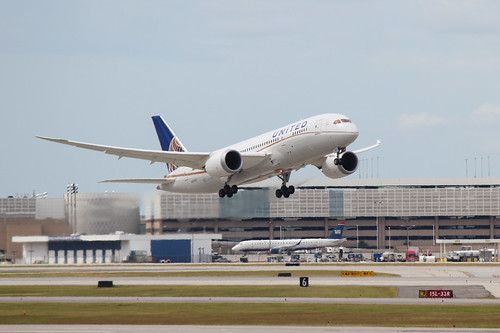When I lived in Houston a buddy and I would grab tacos on Tuesdays together. We tried a few different places but Taconmadre and Karanchos were our favorites. The trompo tacos at Karanchos were something special.
Tag: Texas
Texas Monthly’s Pointless Article on United

Texas Monthly’s recent piece, “Up in the Air” by Loren Steffy, has left me scratching my head. The by-line is “The 2010 sale of Continental Airlines has left Houston in a holding pattern” so I was expecting a look into dealings with the city or the airport. I braced myself for an investigative long-read.
The first two paragraphs focus on how terrible it was to lose Continental to the merger and then United to Chicago; How cultures are a problem.
As a management consultant, Heiland knew that the biggest hurdle for the two companies wouldn’t be integrating systems, processes, or technology but reconciling their cultures. “When it was announced that the headquarters would be in Chicago, I felt the war was lost.”
Then all of the sudden the article becomes a brief history of Continental. Details about former CEOs and what they did or didn’t do for the airline. All of it reads like a Wikipedia job. Then near the end there is some more meat.
And so, in 2010, Smisek struck a deal. Though he called it a merger, he basically sold Continental to United; the name “Continental” disappeared and the Houston headquarters was essentially vacated. Continental’s management team was supposed to be in charge, but it never took root in the cold climes of Chicago. “The Continental culture was a terrible thing to risk,” Bakes says. “United’s history is one of bureaucracy and arrogance, and it ended up culturally being more dominant.”
I get it, there are definite service issues with United. I’m not convinced it had anything to do with “culture” at either airline but more to do with the management not fostering a relationship with the front line staff and building trust. It has lead to distrust and unhappiness for the people who travelers see first and deal with most in their travels: flight attendants, agents, and other ground staff. Morale has been in the mud and it shows. The new CEO, Oscar Munoz, who is on medical leave due to a recent heart attack, mentioned the morale problems and customer service issues immediately after taking the job.
On another note, the part about the Houston offices being vacated is at best an oversight or at worst, poor research. There are a large number of employees who still work in downtown Houston. Just fly a Chicago-Houston morning flight or an evening Houston-Chicago flight, there are a lot of United employees commuting to or from the Houston office.
The whole article reads like a whine and never addresses the by-line. How is Houston in a holding pattern? If anything, United has helped the city before the merger and after. United has committed to paying for at least part of the renovations taking place at Terminal B and C at IAH. The airline also plays a crucial role in attracting other carriers to the city. Their membership in the Star Alliance means that other airlines can codeshare with them, drawing those carriers to offer service to airports where United is located to connect to surrounding cities. EVA, ANA, Singapore Airlines, Air China, Lufthansa and Avianca all offer service to IAH, building on the connections that United offers. And soon there will be a Houston-Auckland flight on Air New Zealand, another Star Alliance partner.
If United had truly left Houston in a holding pattern, it would have happened in a similar fashion to what they did to Cleveland or what Delta did to Cincinnati. Nostalgia is always fun to discuss and reminisce about, but the Texas Monthly article was far from that. I would have been much more of a fan had Texas Monthly found and licensed a bunch of old IAH and Continental photos and just told the history of the airline and the airport. Instead it was a let down.
EVA Air Taipei to Houston
*EVA has now made an official announcement of the Taipei to Houston route, so no more speculation.
It appears as though the much rumored EVA Air Taipei to Houston non-stop service is now official. Well, it’s loaded into the schedule it seems.
Airlineroute.net is reporting that the flight will start on June 21, 2015 and will have the following schedule:
BR52 Taipei to Houston departing 10:00PM arriving 11:25PM [Sun, Tue, Wed, Fri]
BR51 Houston to Taipei departing 1:15AM arriving 5:55AM (+1 day) [Mon, Wed, Thu, Sat]
The actual first flight will be on June 19, 2015 and that flight will arrive at IAH at 5:45pm. My guess is that this flight is timed as a positioning flight to get the aircraft to Houston to operate a day later while still allowing daylight for the press and local officiants to give their speeches.
Taipei to Houston is just under 8,000 miles and will take 14 hours and 25 minutes. The reverse, Houston to Taipei, will clock in at 15 hours and 40 minutes due to winds.
As far as service goes, EVA’s product looks really nice with full lie-flat seats in business and a very decent looking economy product. Ben Schlappig has a number of trip reports on his blog at One Mile at a Time and they are worth a look if you are interested in the EVA product.
It is great to have more options to Asia out of Houston and I think this flight is timed perfectly with connections in Taipei to allow you to get just about anywhere in Asia easily. This will also bring a little more competition to United (even though they are Star Alliance members) and maybe we’ll see some fare sales to Asia!
West Texas
A Nice Day for Spotting
Krugman’s Folly – The Texas Budget and Education
Good ol’ Krugman, once again leaving out important facts in order to wiggle his way into finding some Republican fiscal responsibility for any and all messes.
In his usual way, Mr. Krugman gets straight to the point with this:
And in low-tax, low-spending Texas, the kids are not all right. The high school graduation rate, at just 61.3 percent, puts Texas 43rd out of 50 in state rankings. Nationally, the state ranks fifth in child poverty; it leads in the percentage of children without health insurance. And only 78 percent of Texas children are in excellent or very good health, significantly below the national average.
What he fails to point out is that the majority of the Texas budget is spent both on healthcare and education. How do I know this? Texas conveniently publishes a fact book that you can find here (2010). Page 33 is what you are wanting to read, of $77.6 billion in state revenue, 56.3% was spent on education and 22.8% on health and human services. That amounts to around $43.6 billion spent on education (higher education and public education) and $17.7 billion spent on health and human services. The next closest item on the budget is criminal justice and public safety, which received 9.4% of the state’s budget or $7.3 billion.
Krugman is insinuating that we do not spend enough and that budget cuts will have a deep impact across the state. There’s no doubt that there will be a hit on health and human services but I think the problem is how the funds are being spent within their different agencies, not in the amount the agencies have received before. A lot of mid-sized school districts are estimating $14 million to $20 million a year being cut from their budgets if the plan goes through. If 85% of a district’s money is being spent on personnel, I’d like to see who’s earning what. My money is on the admin side making a decent chunk of change. Maybe some cuts can be made in the admin buildings without making a dent in teacher numbers.
The Texas budget crisis is this, they could cut all other department funding completely and would still have to cut some out of education and health and human services. Tax revenue for the state has dropped to around 2006 levels, which begs the question, why can’t we return to 2006 spending levels? Technically we could, but it would still require personnel cuts in education. The real question is, would it have dire consequences on your children if their classroom size jumped to 30? The research says that the jury is still out on class size having anything to do with graduation rate. Krugman is simply echoing what school districts are screaming across the state which is, “Call your representative! Education is going to die in Texas!”. It’s a little extreme isn’t it? Especially since the estimated budgets for the schools would simply return to 2005 numbers. Have our graduation rates really gone up that much since then? No.
On the chopping block for education are a litany of programs, including parts of the TELPAS program, an assessment for English language learners. While I’m sure the motives behind the program were good, the program has grown to be a beast both in terms of money and in time. And it’s what we are doing with the information we glean from the assessment that is so worrisome. Rather than spending extra time specifically with students who are not English proficient, a lot of districts simply slow the entire class down, in order to avoid the student from feeling awkward. Education’s role is not keeping a student’s social life intact, it’s to educate them.
Another item that people keep insisting would help us is dipping into the state’s rainy day fund, which sits around $9.7 billion. Yeah, that makes a lot of sense, knock down our deficit to $18 billion with our entire savings account, sounds like a stellar plan. Instead, let’s keep that money for a time when we really, really need it.
One of the things I am actually in agreement with Krugman on is the issue of taxes. Most of the state’s budget comes from sales tax and I would be alright with a 1% increase in the tax, taking the rate up to 9.25% (includes local and county collection). Before you tell me how I’m not conservative, let me just explain why this is an acceptable compromise. By raising the sales tax rate, you are not increasing franchise fees or “punishing” the poor, you are simply making it a little more expensive for people to consume. Since a lot of items are not taxable, people have the ability to avoid the taxes or significantly minimize them. The other plus is that sales tax is easy to roll back, while things like franchise taxes and property taxes have a nasty way of sticking around after being implemented.
In the end, something has to give. Either a slight tax increase, budget cuts, or a little bit of both is necessary to get this thing under control. Go to your school board meetings, look at their budget. If they are spending a lot more on administrators than on teachers, call it in to question. Maybe they can make cuts around your district without actually affecting the class room.
Get Out and Vote
Today is the last day of early voting in Texas. If you have early voting in your state today could also be the last day for it.
I don’t care who you vote for but get out there and vote. Read up on your state’s issues, candidates, and news and head to the polls to do your civic duty. November 2nd is election day and midterm elections are just as important as Presidential elections. Get out there and vote!
Spring Has Sprung
The cold has finally been whisked away by springtime and a few weeks ago we took advantage of the weather by taking pictures in the fields of bluebonnets near Chapel Hill, Texas.
 The recent rains we have had along with a little longer and cooler winter have really helped the flowers bloom this year.
The recent rains we have had along with a little longer and cooler winter have really helped the flowers bloom this year.
The only downside to this wonderful weather and its causes are the allergies. Oak pollen has been rampant and those of us with allergies are suffering. This also means summer is only a few months away.
We were able to take a few shots of Sofie but for the most part she was not a fan of walking in the thistles.
The drive to the fields is easy, we just followed 290 west and found as many bluebonnets as we could before pulling over. The further west you go, the more bluebonnets there are. Go far enough west and you will hit Brenham, home of Blue Bell Ice Cream.
So, what are you waiting for? It’s supposed to be another wonderful set of weather this weekend too!
Perplexed Neighborhoods
Today’s question is simple in structure but unbelievably complex in application. Can we restore old neighborhoods without turning them into overpriced and underused parcels of land?
After walking and driving through a number of neighborhoods in Houston that are in dire need of restoration and in the end, residents who care about their community I pondered that question. My quick, off of the cuff answer, at least for Houston, is that it cannot be done. My long, thought out answer is that it can be done but would require numerous people and organizations working together to make it happen.
Just east of downtown there is an area that used to be a warehouse district, complete with a massive rail network. Over the years, as the need for freight in the downtown area has dropped, those warehouses have moved further out of town and left a swath of land with nothing on it. The land is walking distance from downtown, yet most of it stays empty. There has been some development, but for the most part it is just grass. The townhomes that have been built were done quickly and from the looks of it, very cheaply, leaving a lot of them empty. There are no grocery stores or even convenience stores, just warehouses next to grass lots.
The city has decided to build a light rail line through the area, connecting downtown to a slightly more populated neighborhood further east. One would think that this would spur development; It hasn’t. They have also built a bike trail; It’s hardly ridden on.
What’s my point in all of this? The City of Houston and developers have an opportunity to make this area a great example of what urban living could be like. This is a great chance to add to the urban population without making the costs completely unreasonable.
Developers, this is your chance to build capacity without sacrificing history or usability. How you ask? Row style housing at affordable prices, it’s that simple. Build a few blocks of row style houses with maybe a garage on the bottom and people will start to move in. Give the homes small backyards and decent spacing between the front door and the road and people will be happy.
City of Houston, setup the neighborhoods with decent parking markings for street parking, add a few bus stops, and repair the roads. The people will move in. These are large investments for predicted returns, but they’re worth it. Right now that land is barely generating anything as far as property taxes, there is nowhere for it to go but up.
Maybe I am a daydreamer or grasping at straws, but I do have hope that Houston sees the different run down neighborhoods around the city as potential, rather than lost causes. I talk about this subject with my wife pretty often, usually as we are driving through these neighborhoods. I’ll look at an old building and make some remark like, “Wouldn’t that be an awesome office?”, maybe someone with the time and wherewithal has the same feeling.
Land Thieves
As the University of Texas takes on the University of Oklahoma, I thought it prudent to point what exactly a “Sooner” is.
Sooner is the name first applied about six months after the Land Run of 1889 to people who entered the Oklahoma District (Unassigned Lands) before the designated time. The term derived from a section in the Indian Appropriation Act of March 2, 1889, which became known as the “sooner clause.” It stated that no person should be permitted to enter upon and occupy the land before the time designated in the president’s opening proclamation and that anyone who violated the provision would be denied a right to the land.
Illegal claimants were initially called “moonshiners,” because they entered the area “by the light of the moon.” Sooners or moonshiners hid out in brush or ravines, then suddenly appeared to stake a claim after the run started, giving them clear advantage over law-abiding settlers who made the run from the borders.
If you didn’t feel like reading through all of that, I’ll sum it up in a word; Cheaters. How fitting then is it for the Oklahoma mascot to be a Sooner.
This is the one day a year I can happily say:
Hook ‘Em Horns!









